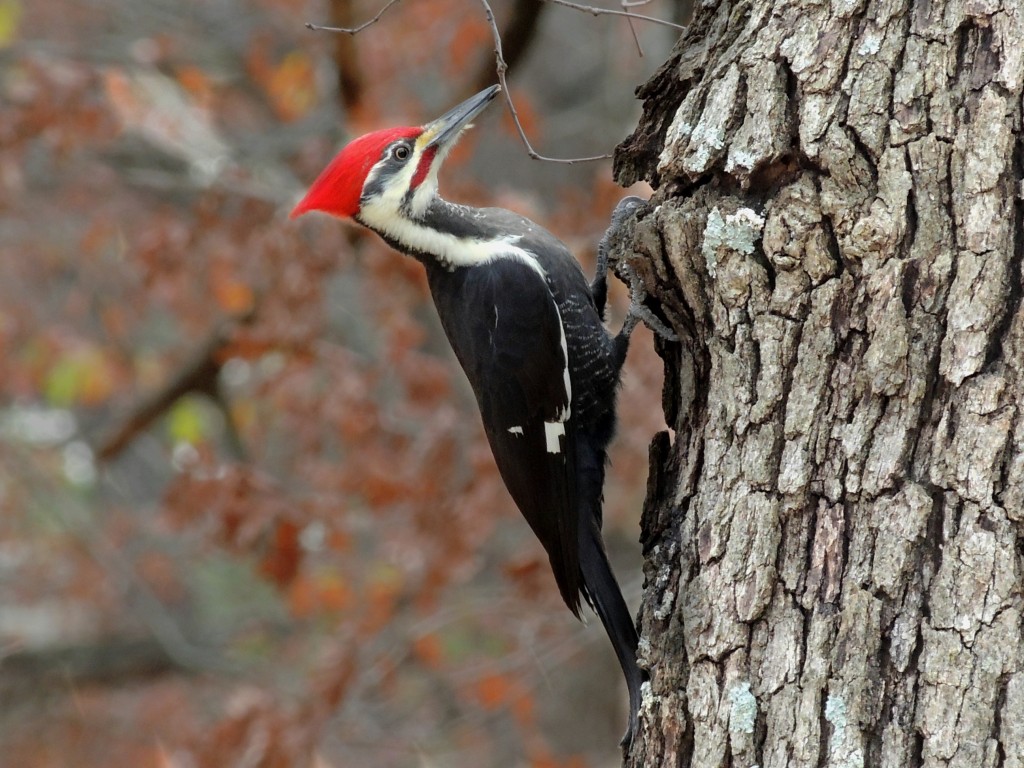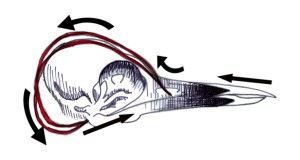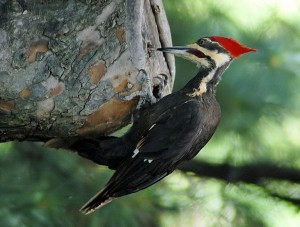Why Does a Woodpecker Not Bash Its Brains In When It Pecks?

Protections of the Woodpecker for Pecking
Have you ever seen a flicker or woodpecker pounding away at bark, or annoyingly on a tin roof, and wondered how in the world they can do that without bashing in their brains? After all, the force of that is measured at over 1,000x the force of gravity! The answer is pretty complex, but you can break it down into some simple parts:
Woodpeckers Sit Funny
If you ever look at a woodpecker on a tree, you'll notice that before they start bashing their beak against bark, they dip their tail backwards against the tree trunk. In fact, their tail feathers are pointed, to allow just for this "resting" motion.

When a woodpecker sits like this, and then it pecks, the muscles in its neck absorb the shock of the pecking from the head and transmit it into the shoulders, upper torso, into the tail, and then back into the tree. It's a circular dispersion of energy.
Woodpeckers Have Body Builder Necks
Woodpeckers also have the avian equivalent of necks like "Arnold" with super strong muscles that would make a body-builder jealous. These neck muscles also divert and absorb shock.
Woodpeckers Have Spongy Bone Helmets
The brains of woodpeckers are protected by their skull bone. Inside the skull bone is quite a bit of spongy bone, layered in plates, which acts like a built in football helmet that protects their grey matter.
Woodpeckers Have Tongues that Wrap Around Their Skulls
Take your fingers and feel the hyoid bone that is just at junction of your throat and jaw line, right where your trachea is. You should feel two little bones sticking out. On us this bone is used for muscle attachment that helps with swallowing and it supports the tongue. Unlike woodpeckers, we don't have bones or cartilage in our tongues, it's just a big muscle. In woodpeckers that bone is modified to be super long. It starts in their two nasal cavities (as two separate bones) where it attaches. These bones/muscles run over the brain, around the side of the head, under the lower jaw, and into the mouth, where the two bones meet to form the tongue.

When a woodpecker pecks, these tongue bones are retracted and stabilize the skull, providing musculo-sketal support. This bone helps absorb shock too.
Woodpeckers Have An Overbite
A woodpecker's beak is made of two layers, an inner layer of strong and dense bone, and an outer layer of flexible tissue that is softer. The upper beak is slightly longer than the lower beak (birdy overbite), but the lower beak has a slightly longer inner layer of hard and dense bone.
Here's the woodpecker hokey pokey of energy absorption: If you put the hyoid tongue bone into this picture then when a woodpecker pecks, the shock of impact travels from the outer spongy material, into the hard support bone, through the hyoid muscles, around the head, where it diverts back into the lower long jaw bone (of hard bone), and the tongue.

Woodpeckers Have Long Brains
If you look at the skull of a woodpecker you'll notice that their brain case is elongated. This elongation also helps with micro absorption of shock. There is greater surface area of the brain to absorb the concussions compared to the relatively rotund brain of humans. On a size to length ratio, woodpeckers have us "beat."

Woodpeckers Have Very Little Fluid On The Brain
Most animals have a pretty good amount of fluid, called cerebrospinal fluid (CBF), surrounding their brain, which allows the brain to somewhat "float" inside the brain case. Woodpeckers have very little space between their spongy brain case and their brain, so there's not much room for fluid. This is good, because without all the fluid the woodpeckers brains won't turn into scrambled eggs during the pecking and pounding.
Woodpeckers Have Goggles So Their Eyes Won't Pop Out
Another way that woodpeckers deal with the physical stresses of pecking is protecting their eyeballs from popping out (after all, they're dealing with over 1,000g of pressure!). They have an upper and lower eyelid like we do, but theirs are super thick. They also have a third eyelid, called the nictating membrane (Nictare in Greek means to blink), which moves horizontally instead of vertically across their eye. This eyelid closes a millisecond before the beak starts pounding away. It helps the woodpecker keep debris out and its eyeballs in.
Woodpeckers have a lot of really interesting adaptations help them keep from bashing their brains in when they peck. Researchers have found that all of these adaptations absorb up to 99.7% of the shock of their pounding! This leaves a meager .3% that goes to the brain and head, which is a good thing if you're a bird that likes to pound bark. Next time you see a woodpecker pounding away at a tree, or on your roof, take a moment to study it and marvel at these amazing adaptations.

